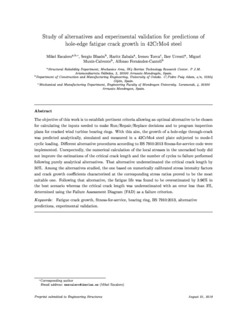Title
Study of alternatives and experimental validation for predictions of hole-edge fatigue crack growth in 42CrMo4 steelAuthor
Author (from another institution)
xmlui.dri2xhtml.METS-1.0.item-contributorOtherinstitution
https://ror.org/03hp1m080https://ror.org/006gksa02
Version
http://purl.org/coar/version/c_ab4af688f83e57aa
Rights
© 2018 Elsevier Ltd. All rights reserved.Access
http://purl.org/coar/access_right/c_abf2Publisher’s version
https://doi.org/10.1016/j.engstruct.2018.09.017Published at
Engineering Structures Vol. 176. Pp. 621-631. 1 December, 2018xmlui.dri2xhtml.METS-1.0.item-publicationfirstpage
621xmlui.dri2xhtml.METS-1.0.item-publicationlastpage
631Publisher
ElsevierKeywords
Fatigue crack growth
Fitness-for-service
Bearing ring
BS 7910:2013 ... [+]
Fitness-for-service
Bearing ring
BS 7910:2013 ... [+]
Fatigue crack growth
Fitness-for-service
Bearing ring
BS 7910:2013
Alternative predictions
Experimental validation [-]
Fitness-for-service
Bearing ring
BS 7910:2013
Alternative predictions
Experimental validation [-]
Abstract
The objective of this work is to establish pertinent criteria allowing an optimal alternative to be chosen for calculating the inputs needed to make Run/Repair/Replace decisions and to program inspect ... [+]
The objective of this work is to establish pertinent criteria allowing an optimal alternative to be chosen for calculating the inputs needed to make Run/Repair/Replace decisions and to program inspection plans for cracked wind turbine bearing rings. With this aim, the growth of a hole-edge through-crack was predicted analytically, simulated and measured in a 42CrMo4 steel plate subjected to mode-I cyclic loading. Different alternative procedures according to BS 7910:2013 fitness-for-service code were implemented. Unexpectedly, the numerical calculation of the local stresses in the uncracked body did not improve the estimations of the critical crack length and the number of cycles to failure performed following purely analytical alternatives. That alternative underestimated the critical crack length by 50%. Among the alternatives studied, the one based on numerically calibrated stress intensity factors and crack growth coefficients characterized at the corresponding stress ratios proved to be the most suitable one. Following that alternative, the fatigue life was found to be overestimated by 3.96% in the best scenario whereas the critical crack length was underestimated with an error less than 3%, determined using the Failure Assessment Diagram (FAD) as a failure criterion. [-]
Collections
- Articles - Engineering [684]






















